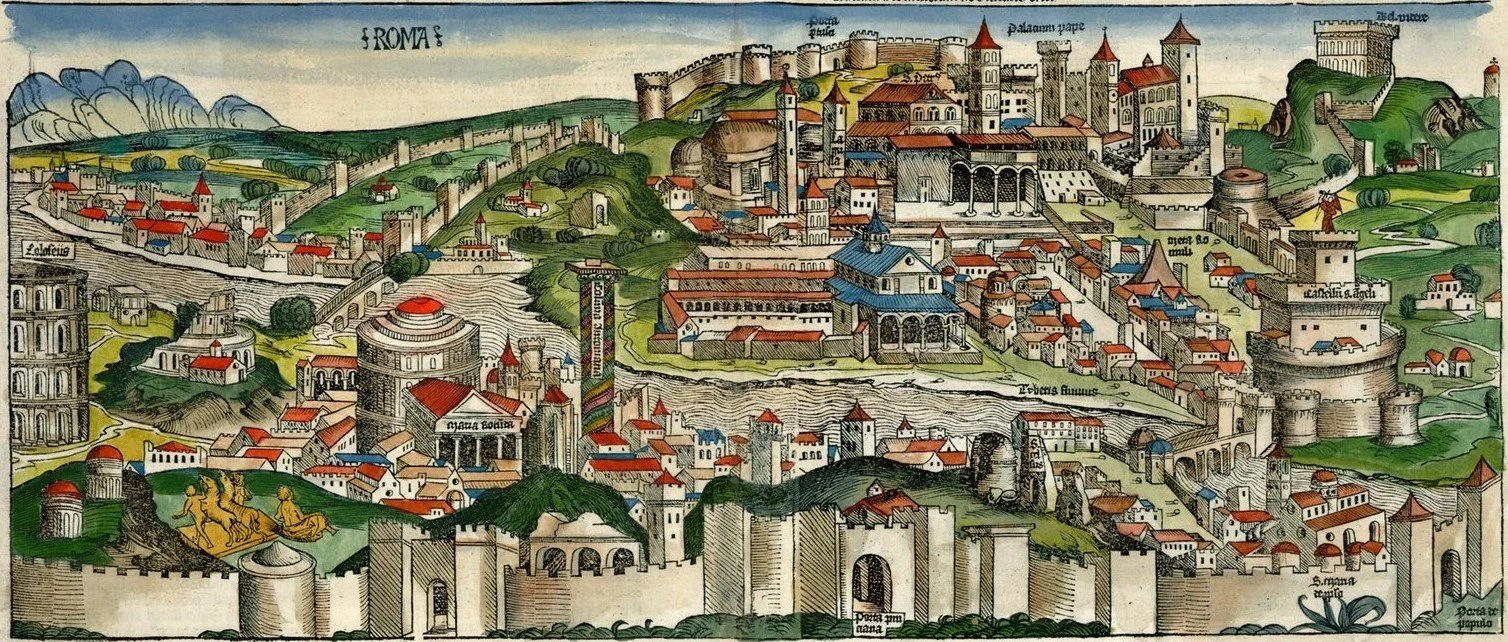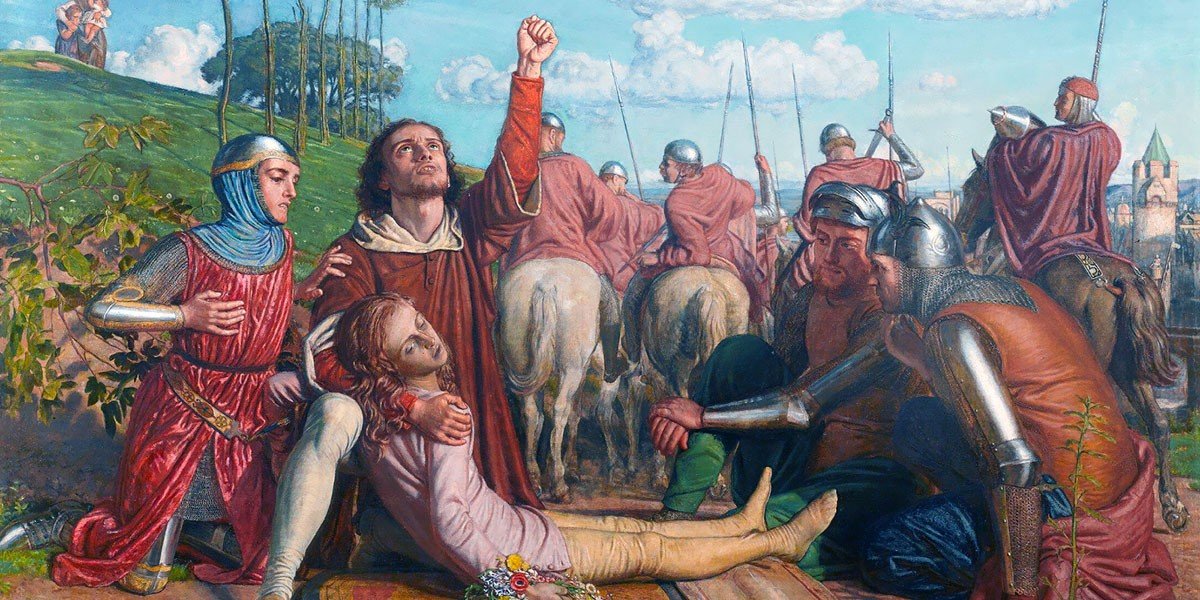Cola di Rienzo and the Dream of Ancient Rome
The medieval period was obsessed with the idea of ancient Rome. But the city in the mid-14th century was not what she used to be.
The population had dwindled down to 30,000 with much of the city behind the ancient walls now given over to untamed wilds. With the papacy in Avignon, control of the city had devolved to the rule of the barons—powerful noble families who could trace their ancestry back to cardinals and popes. Recently these families had fought a civil war for control of Rome, leading to chaos.
The Chronicle of the Anonymous Roman, one of the best primary sources for this time, described robbery, rape, and murder as common occurrences. Out of this chaos, the people of Rome finally overthrew the barons and sent a delegation of their new republican government in 1342 to Pope Clement VI in Avignon.
The leader of this delegation was Cola di Rienzo. And he had a dream to recreate the Roman Republic.
Late Medieval and Renaissance Rome in the Nuremberg Chronicle (1493).
Son of an Innkeeper
Cola di Rienzo at Rome (1930), by Tancredi Scarpelli (1866-1937)
From Storia d’Italia (History of Rome) by Paolo Giudici
Cola was not a noble. He was instead the son of an innkeeper. Cola was a nickname for Nicholas, thus his name would translate to something like “Nick, son of Larry” in English. This son of an innkeeper was likely born in 1313 and had been raised by an uncle in Anagni where he learned to become a notary.
When the delegation arrived, Cola asked the pope to abandon his luxurious palace at Avignon and return to Rome. Clement politely declined. But the trip was not a complete failure. Clement had seen something in the 29-year-old Cola. And he was not the only one. While in Avignon, Cola met and befriended the poet Petrarch, a man who shared with Cola his dreams of recreating the ancient Roman Republic.
When the pope finally sent the delegation back home to Rome, he had already appointed two new Senators—barons who technically ruled Rome for a one-year term. But he realized that as long as the barons controlled Rome, he would have trouble collecting the lucrative salt tax. So, Clement sent in a secret weapon: he appointed Cola as the official papal notary, a position with the backing of the pope to check the power of the Senators. And, importantly, one that had an indefinite term.
Cola, an idealist with a hatred for the barons, was unleashed.
The Tribune of the People
With papal funds, Cola commissioned art, painted on the side of public buildings, depicting the city of Rome as an old widow assaulted by monsters, who were clearly labeled as the barons. At first, the barons thought it was funny. The families would invite him to dinner and have him repeat his threats while they laughed. But when Cola denounced them in public in front of the masses, one of the Colonna stood up and slapped him. There was no going back from that.
Cola di Rienzo Contemplating the Ruins of Ancient Rome (1855), by Federico Faruffini (1831-1869).
On May 19, 1347, Cola made his move. While the barons and their armies were outside the city, Cola and his supporters mounted the steps of the Palace of Campidoglio. It was here that Cola established the “Good Estate,” enacted laws to preserve peace, and named himself the Tribune of the People in a bloodless coup.
The barons tried to mount an attack on the new government, but they didn’t trust each other. But after a few incarcerations and a couple executions, they realized that if they wanted to survive, they would have to work together.
Meanwhile Cola proclaimed his new state to the world, summoning the other city-states of Italy to come and join a new alliance—with Rome as its center. While many cities did pledge fealty, Cola’s dream of a revitalized Roman Republic was still new and many city-states, like Florence, were unwilling to join if it meant giving up their own authority.
Personally, I think they were also waiting to see what would happen.
Wolves at the Gate
Six months after Cola declared himself Tribune, the barons gathered a large army and marched on the city. The first to ride through the open gate was Janni Colonna. He was also the first to realize it was a trap.
Cola defeated the barons’ army in a stunning victory at Porta San Lorenzo on November 20, 1347. Less than a month later, he was on the run. Pope Clement, the man who had financed Cola’s revolution, was afraid of his pawn’s success and popularity. Leveraging the entire weight of papal politics, Clement was able to trump up charges of heresy against Cola and convince some of his allies to turn on him. On December 15th, a mercenary captain threw up a barricade in defiance of the regime. When Cola sounded the bell to call his men to arms, no one came.
Realizing that he had been outmaneuvered, Cola went into hiding. Putting his wife and son into monasteries for their protection, he ran south to get help from the Kingdom of Naples.
The next year was 1348—the year the Black Death arrived in Italy. Seemingly without hope, Cola fled to a group of apocalyptic hermits living in the Abruzzi Mountains of central Italy, where he stayed for two years.
Son of an Emperor
Cola did not give up, however. He eventually journeyed to the court of Emperor Charles IV in Prague, where he would ask the emperor’s help to return him to power in Rome. He maintained his usual rhetoric of rebuilding the Roman Republic, but also added Apocalyptic prophecies that he interpreted as proof that Charles was the “Last World Emperor,” the final ruler who would lead Christendom into a golden age. Cola also claimed in one of his letters to the emperor that they were related, and that Cola was the bastard son of the late Emperor Henry VII.
Rienzo vowing to obtain justice for the death of his young brother, slain in a skirmish between the Colonna and the Orsini factions (1849), by William Holman Hunt (1827-1910).
The death of Cola’s brother during the barons’ civil war is alluded to in the Chronicle of the Anonymous Roman, but otherwise there is no evidence that it ever happened and Cola never mentions it in his letters.
Whether he was actually the son of the emperor is doubtful. At that point Charles, fearful of outright defying an angry Pope Clement, had placed Cola under house arrest and the letter where he claimed that Charles’ grandfather had seduced Cola’s mother was a desperate attempt to get out of jail. But despite Cola’s ill-conceived gambit, and despite the calls from Avignon, Charles actually liked the eloquent Roman. Like Petrarch and Clement before him, the emperor was charmed by Cola’s intelligence and charisma. Just not enough to free him.
Tired and sick with epilepsy, Cola realized that he had one last move to make if he ever wanted a chance to return to Rome: he had to go to Avignon and surrender to Pope Clement. Widely regarded as the greatest orator of his day, and well versed in law, Cola knew that he could defeat the charge of heresy. And if Cola approached the pope directly and challenged him in front of the papal court, then Clement couldn’t make him disappear.
Clement was furious. But he couldn’t afford to put the widely popular Cola on trial. The Roman might, after all, win. So, over the next few years, Cola languished in a tower in Avignon, entertaining foreign dignitaries and reading classical books by Ovid and Cicero while he was chained to a wall.
But eventually Clement died and the new pope, Innocent VI, realized that Cola was the perfect instrument to help him reestablish control over the chaotic and fractured Papal States of central Italy. Innocent freed Cola from captivity and told his legate to aid Cola in overthrowing the rule of the barons and returning papal authority to Rome.
Son of Rome
The only problem was the papal legate.
Cardinal Albornoz was an ambitious and worldly man who hated Cola. If Cola wanted to return home, he would need a new ally.
That ally came in the form of Fra Morreale, the leader of the Great Company—a mercenary company whose infamy was legendary. But Cola was desperate. Borrowing money from friendly city-states, and with the promises of greater riches once he returned to power, Cola was able to hire Morreale and the Great Company to come with him to Rome. At the head of an army, and seven years after he had been driven out, Cola was returning home.
Hearing that he was returning, the people of Rome once again threw off the baronial rule and welcomed Cola back with open arms. This was a problem. Without a battle against the barons, Cola had no loot to pay the mercenaries. And Morreale was not a man to cross. The mercenary captain began to enact the plan he had concocted from the beginning—to take over Rome for himself. But, luckily, the plan was revealed to Cola by one of the Great Company’s “maids.” Morreale and his conspirators were executed.
Monument to Cola di Rienzo (1870) by Girolamo Masini (1840-85).
This bronze statue is located at the base of the Piazza di Campidoglio in Rome, not far from where he was killed
Many of the barons were cowed, but while a few others were in open revolt, their war was going poorly as Cola’s forces kept them on the defensive. Oddly enough, having survived and done so much, that was when Cola’s luck ran out.
A mob formed in front of the Palace of Campidoglio after Cola levied a new tax on wine, shouting “Death to the traitor Cola di Rienzo.” Realizing that he needed to escape as the rioters set fire to the building, Cola disguised himself in a dirty cloak and escaped down to the street. Passing through the mob, he couldn’t help but raise a fist to shout with the masses.
This was a mistake. Someone noticed the rings and jewelry on his arm and stopped him. He was unmasked and killed by the mob, who then burned his body as a heretic. The barons then forced the city’s Jews, some of Cola’s most loyal supporters, to shovel his ashes into the Tiber.
He had not been back two months.
Afterlife
Cola’s dream died with him on October 8th, 1354. He was 41.
While the Good Estate did not survive, the power of the Roman people endured. Even the popes, when they eventually returned in 1377, had to contend with them.
Cola di Rienzo has been interpreted by historians in many different ways. He has been a romantic figure, a revolutionary hero, a dangerous madman, a proto-fascist, a proto-communist, and a sad joke. Recently, other historians have interpreted him much the same way as I have: as an idealist who tried to do his best in a world that did everything it could to stop him.
Written by Ian Geary
See more from Ian via his social media - @hardboiledhistorian
Further Reading
Anonymous Roman. The Life of Cola di Rienzo. Translated by John Wright. Toronto: Pontifical Institute of Medieval Studies, 2019.
Collins, Amanda. Greater Than Emperor: Cola di Rienzo (ca. 1313-54) and the World of Fourteenth-Century Rome. Ann Arbor: University of Michigan Press, 2002.
Musto, Ronald G. Apocalypse in Rome: Cola di Rienzo and the Politics of a New Age. London: University of California Press, 2003.
Palmer, James A. The Virtues of Economy: Governance, Power, Piety in Late Medieval Rome. London: Cornell University Press, 2019.
Petrarch, Francesco. Petrarch: The Revolution of Cola di Rienzo. Edited by Mario Emilio Cosenza. New York: Italica Press, 1996.






